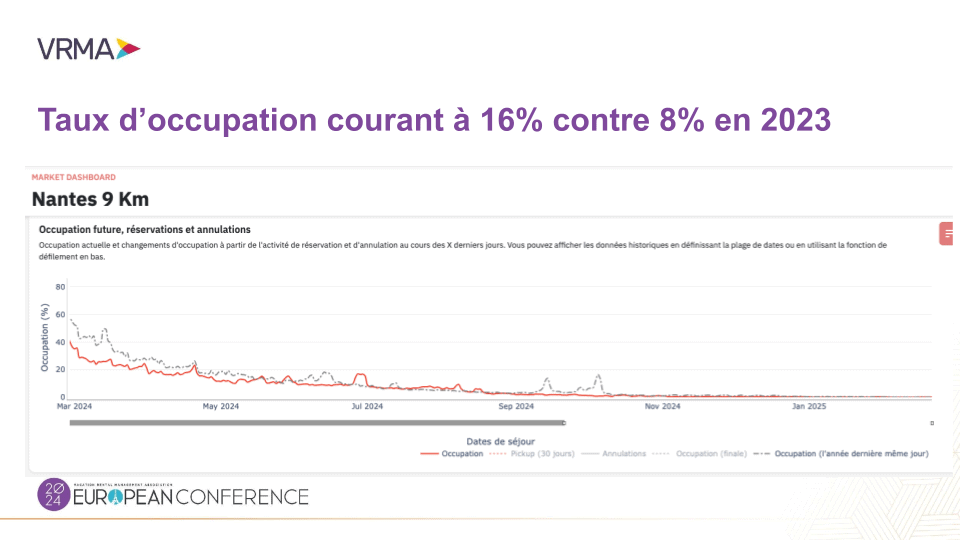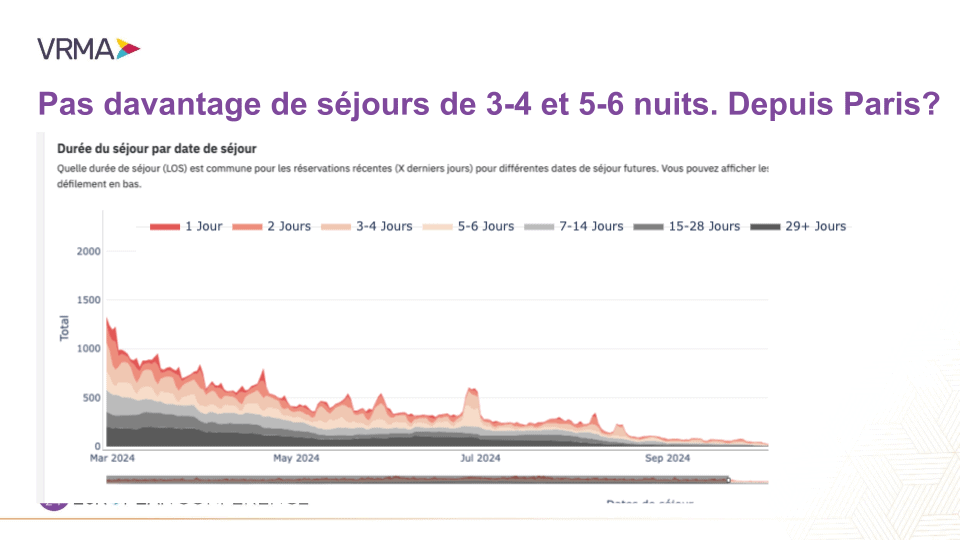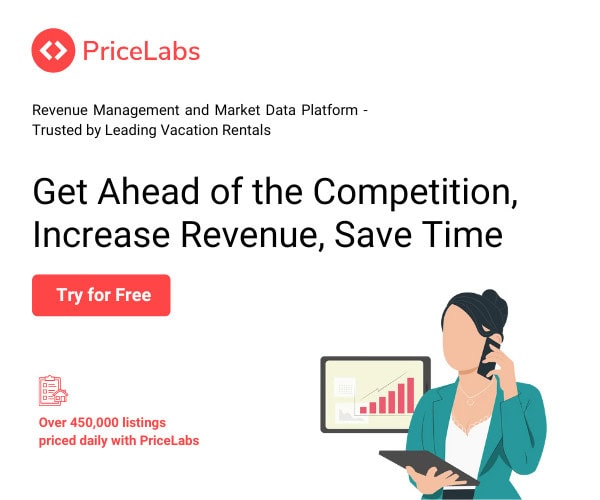In an era where data reigns supreme and algorithms dictate a significant portion of our decision-making processes, short-term rental (STR) managers find themselves at a crossroads. The allure of dynamic pricing tools promises optimized profits and streamlined operations, yet the question remains: how can managers reclaim control from these digital overlords?
The 2024 VRMA European Conference in Paris unveiled disruptive strategies for reclaiming control from the algorithms that dictate pricing. The session, a collaboration between Antoine Hervo of Hoomy and Thibault Masson of PriceLabs, provided a deep dive into transforming dynamic pricing from a tool to an ally. As we edge closer to the 2024 Olympic Games, with cities from Nantes to Paris preparing for an influx of visitors, understanding the mechanics behind pricing algorithms and integrating your unique insights becomes crucial.
This presentation tackled pressing questions: How can you tailor your pricing strategy for events like the Olympics? What are the inner workings of a pricing algorithm? How do you balance algorithmic suggestions with your expertise? With the spotlight on setting strategic frameworks adaptable to seasons and major events, this session offered a blueprint for STR managers to not only navigate but excel in the competitive rental landscape.
In this article we distill key takeaways from their presentation to illustrate how to blend data-driven decisions with industry know-how to optimize profits.
2024 Olympic Games: Price Surge and Strategic Adaptation From Nantes to Paris
As the anticipation for the 2024 Olympic Games builds, the landscape of short-term rentals undergoes a transformation from Nantes to Paris, echoing the pulse of this global event.
Nantes: Early Signs of Olympic Influence

As the Olympic wave begins to swell, Nantes has already started feeling its impact, with its occupancy rates soaring to 16%—a remarkable leap from the previous year’s 8%. This uptick prompts a deeper exploration into what’s driving such growth. While the Olympics play a central role, other factors also contribute to this surge.

Notably, the changing patterns in visitor stays, with traditional 3-6 night bookings becoming less common, hint at a broader shift possibly tied to Nantes’ proximity to Paris and events at La Beaujoire Stadium.
Paris: The Epicenter of Olympic Fever
Paris Intra Muros: Within the heart of Paris, the occupancy rate has more than doubled compared to last year, reflecting the city’s high season brought on by the Olympics. The price per night has seen a significant increase of 1.8 times over the previous year, while inventory levels have grown by 1.3 times from February 2023 to February 2024. This data underscores the heightened demand for accommodations in Paris, driven by its central role in the Olympics.
Saint-Denis – Grand Stade Area: The vicinity of the Grand Stade in Saint-Denis, a key Olympic venue, presents even more stark changes. Occupancy rates have astonishingly multiplied by seven from the previous year. Nightly prices have increased by 2.6 times, and the inventory has seen a 1.8 times growth from February 2023 to February 2024. Interestingly, the trend towards longer stays isn’t as pronounced here, suggesting a distinct visitor profile compared to central Paris.
Demystifying Pricing Algorithms: How Does It All Work?
From Algorithm to Results: The Six-Step Process
1. Gathering Data: The foundation of any robust pricing algorithm begins with collecting extensive data from various sources. This includes information from popular platforms like Airbnb, Booking.com, Vrbo, and analytical tools such as Key Data, along with holiday and event schedules for comprehensive insight.
2. Data Refinement: Following collection, the data undergoes a meticulous cleaning process. This step involves removing duplicates, filtering out unavailable dates, and excluding inactive listings to ensure the data’s accuracy.
3. Hyper-Local Analysis: At the heart of the algorithm lies the Hyper Local Pulse Recommendation system. This sophisticated mechanism focuses on extracting hyper-local insights, ensuring that the price recommendations are not only accurate but supremely relevant to your specific location.
4. Strategic Customization: Equipped with precise insights, the algorithm enables users to craft tailored pricing strategies. This customization aligns with individual business objectives and the unique dynamics of the local market.
5. Seamless Integration: The algorithm ensures that optimized prices are automatically updated in your Property Management System (PMS) or Channel Manager, keeping your listings competitive without manual intervention.
6. Performance Insights: The final phase involves analyzing detailed reports and performance metrics. This critical feedback allows for continuous refinement of pricing strategies based on actual results.
Hyper-Local Data: The Core of Precision
At its heart, the algorithm thrives on hyper-local data, pinpointing the most relevant comparables to provide real-time pricing recommendations. By capturing the nuances of small geographic areas and incorporating up-to-date market data, it offers unmatched precision in its pricing advice, considering factors like seasonality, demand, and occupancy rates.
User Customizations: Empowering Hosts with Flexibility
Recognizing the diversity of short-term rental operations, the algorithm offers a wide array of customization options. Whether adjusting for seasonal trends, setting minimum stay requirements, or configuring for special events, hosts can fine-tune their pricing to match their specific needs and goals. This flexibility extends to managing stay restrictions, offering control over aspects such as check-in/check-out times and minimum stay policies, ensuring that each property is optimally positioned in the market.
Mastering Pricing Algorithms: Establish A Framework To Make The Most Of It
The efficacy of pricing these algorithms is significantly enhanced when they operate within a well-defined framework. This structured approach not only ensures that the algorithm functions optimally but also safeguards the host’s control over their pricing strategy.
A well-conceived framework serves as the navigational chart for pricing algorithms, guiding them to operate within specific boundaries. This is crucial for several reasons:
- Control and Flexibility: It guarantees that while the algorithm dynamically responds to market fluctuations, it does so within the strategic confines set by the host. This delicate balance ensures that control remains firmly in the hands of the host, aligning closely with their business objectives.
- Enhanced Collaboration with Human Intelligence: The fusion of algorithmic precision and human insight creates a formidable team. A structured framework allows the algorithm to enhance human expertise, blending deep market insights with data-driven recommendations. This synergy can unlock new revenue opportunities, marrying intuition with analytics for optimal pricing strategies.
- Confidence in Decision Making: With a solid framework and a robust market analysis tool, hosts can navigate the pricing landscape with greater confidence. Understanding the nuances of one’s specific market segment—be it the city’s overall pricing trends or the peculiarities of certain types of accommodations—enables informed decision-making that aligns with both data and intuition.
The Role of Frameworks in Strategic Decisions
The value of a strategic framework extends beyond setting operational guidelines for algorithms—it’s crucial for evaluating performance and steering strategic decisions. Here’s how:
- Benchmarking Excellence: By enabling precise comparisons within specific market segments, such as analyzing all two-bedroom seafront apartments against their peers, hosts can gain actionable insights. This focused benchmarking approach is more informative than broader comparisons, offering clear direction for pricing adjustments and marketing strategies.
- The Power of Tags: Incorporating tags within your analysis framework is a game-changer. Tags allow for detailed categorization and comparison, shedding light on performance trends, areas for improvement, and competitive advantages. This level of detail supports nuanced analysis and strategic planning.
- Cultivating a Data-Driven Culture: A comprehensive framework encourages a data-centric approach to decision-making. Regularly reviewing performance metrics within this framework reveals patterns, forecasts market shifts, and hones pricing strategies. The result? Staying competitive and maximizing profitability through informed, data-backed decisions.
The Importance of Implementing Seasonal Frameworks in Pricing Strategies
Relying on a one-size-fits-all pricing model could be holding your property back from reaching its full market potential and profitability. The truth is, the demand in the short-term rental market ebbs and flows with the seasons, and your pricing strategy needs to keep pace with these changes to stay ahead.
Adapting to Seasonal Variations: A Necessity for Optimal Pricing
The short-term rental market is anything but static — it’s a rollercoaster of peak and quiet seasons, each bringing its own opportunities and challenges. To master this fluctuating landscape, it’s crucial to tailor your pricing approach to the unique characteristics of each season.
Embracing Flexibility During Quieter Times
In the slower seasons, when the pressure is off, allowing your pricing strategy some breathing room can pay off. By adopting a more flexible framework, you’re able to make dynamic adjustments — think special deals or incentives for extended stays — to keep your occupancy high even when demand isn’t.
Strategic Moves for Peak Seasons
On the flip side, the bustling high season calls for a more calculated approach. If your aim is to attract longer bookings during these busy times, tweaking your pricing model to avoid overly high nightly rates is key. Setting a cap on prices helps ensure your offers remain attractive and competitive, aligning with your overarching business goals.
Harnessing the Power of Seasonal Profiles in Pricing Tools
Modern pricing tools like Price Labs, Beyond, and Wheelhouse aren’t just about setting rates; they empower hosts to tailor their pricing strategies seasonally. With features that allow for the creation of detailed seasonal profiles, hosts can fine-tune their approach with rules that cover everything from special rates for specific nights to minimum stay requirements and last-minute deals. Implementing these profiles across your listings ensures a unified, strategic response to market fluctuations.
When to Consider a Dynamic Pricing Expert or Advanced Tools?
While pricing algorithms and tools offer significant advantages in automating and optimizing pricing strategies, there are scenarios where the expertise of a sophisticated and specialized tool becomes invaluable. This is particularly true when integrating complex discount strategies and promotions on Online Travel Agents (OTAs). A technical Revenue Manager (RM) or sophisticated tools may be required to manage and track these promotions effectively, ensuring they align with the overall pricing framework while maintaining market competitiveness.
Additionally, the interpretation of data and strategic decision-making based on analytical insights often necessitate a level of expertise beyond what automated tools can provide. In these instances, a skilled RM can complement the intelligence of pricing algorithms, offering a strategic advantage in maximizing revenue potential.
Major Events: Mix the Algorithm with Your Know-How!
Major events such as the Olympic Games or the Rugby World Cup present unique opportunities for hosts and property managers to significantly boost their revenue. However, capitalizing on these occasions demands a sophisticated blend of algorithmic efficiency and nuanced market understanding.
Mastering Event-Driven Pricing Dynamics
Major sporting and cultural events can dramatically alter the demand landscape, often leading to a surge in potential earnings for short-term rental properties located in or around event venues. Yet, navigating these waters requires more than just jacking up prices; it calls for a strategic approach that balances profitability with customer experience.
- Anticipating Demand Shifts: Advanced planning is crucial. Utilize pricing tools that offer calendar functionalities extending years into the future, allowing you to prepare for big events well in advance. Setting minimum length-of-stay requirements based on anticipated traveler behavior—such as preferring at least six-night stays for the duration of an event—can help secure longer bookings and reduce vacancy periods.
- Pricing Responsibly: While it’s tempting to significantly increase prices during major events, striking the right balance is key. For example, during the Rugby World Cup, Antoine opted to double or triple his usual rates rather than increase them tenfold. This strategy aims to offer guests a good value proposition—a quality stay at a fair price—that they’re less likely to cancel. The higher the price, the greater the risk of cancellations, as guests may continue to shop around for better deals.
Interpreting Market Signals for Event Pricing
Understanding the nuances of event-driven pricing goes beyond setting rates based on expected demand. It involves a deep dive into market dynamics and consumer behavior to avoid common pitfalls and optimize pricing strategies.
- Assessing Market Listings: Seeing high-priced listings on platforms like Airbnb might give the impression of a market trend, but it’s essential to remember—if a listing is visible, it’s likely not booked. Thibault emphasizes the importance of discerning between listed prices and actual booking rates to avoid overestimating the market value.
- Utilizing Pacing Data: Tools like Price Labs offer pacing data, which can be invaluable in gauging how quickly properties are being booked for upcoming events. This insight allows hosts to adjust their pricing strategies in real-time, ensuring they remain competitive and attractive to potential guests.
- Collaborating with Peers: Engaging in discussions with other market players can provide additional perspectives on event-driven pricing strategies. Sharing experiences and insights can help form a more comprehensive understanding of market trends and consumer expectations, enabling hosts to make informed decisions.
From decoding the intricacies of pricing algorithms to navigating major events and defining strategic frameworks, the journey to balance algorithmic precision with managerial expertise is marked by continual adaptation and innovation. Through collaboration, insight-sharing, and a commitment to leveraging technology alongside human insight, managers can unlock the full potential of their properties, maximizing profitability while delivering exceptional guest experiences. The symbiotic relationship between data-driven tools and human ingenuity remains the cornerstone of success, propelling the industry towards new heights of efficiency, profitability, and guest satisfaction.




![Trump-Era Policies Fuel Travel Uncertainty: Fewer Canadians, Europeans to U.S.—Fewer Americans to Europe [Early Data]](https://www.rentalscaleup.com/wp-content/uploads/2025/04/Trump-Era-Policies-Fuel-Travel-Uncertainty-Fewer-Canadians-Europeans-to-U.S.—Fewer-Americans-to-Europe-Early-Data-150x150.jpg)



